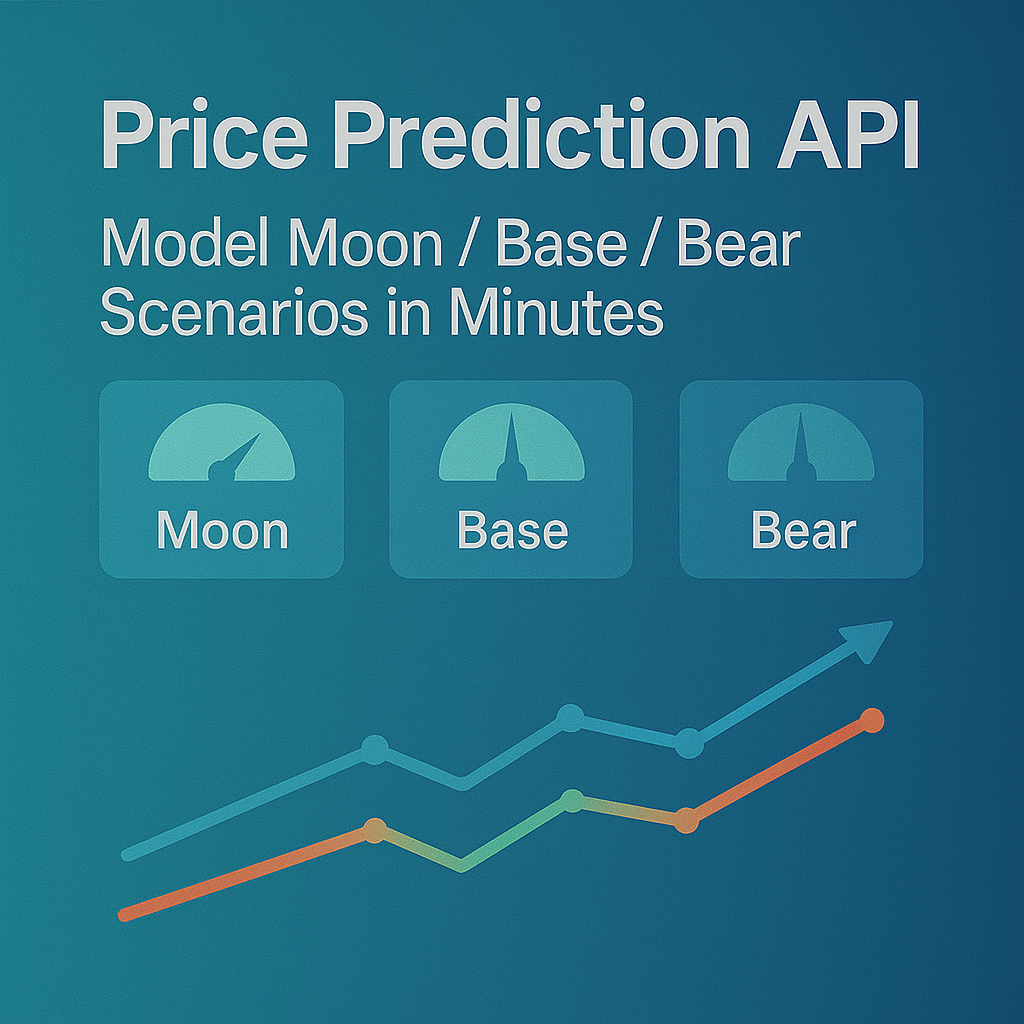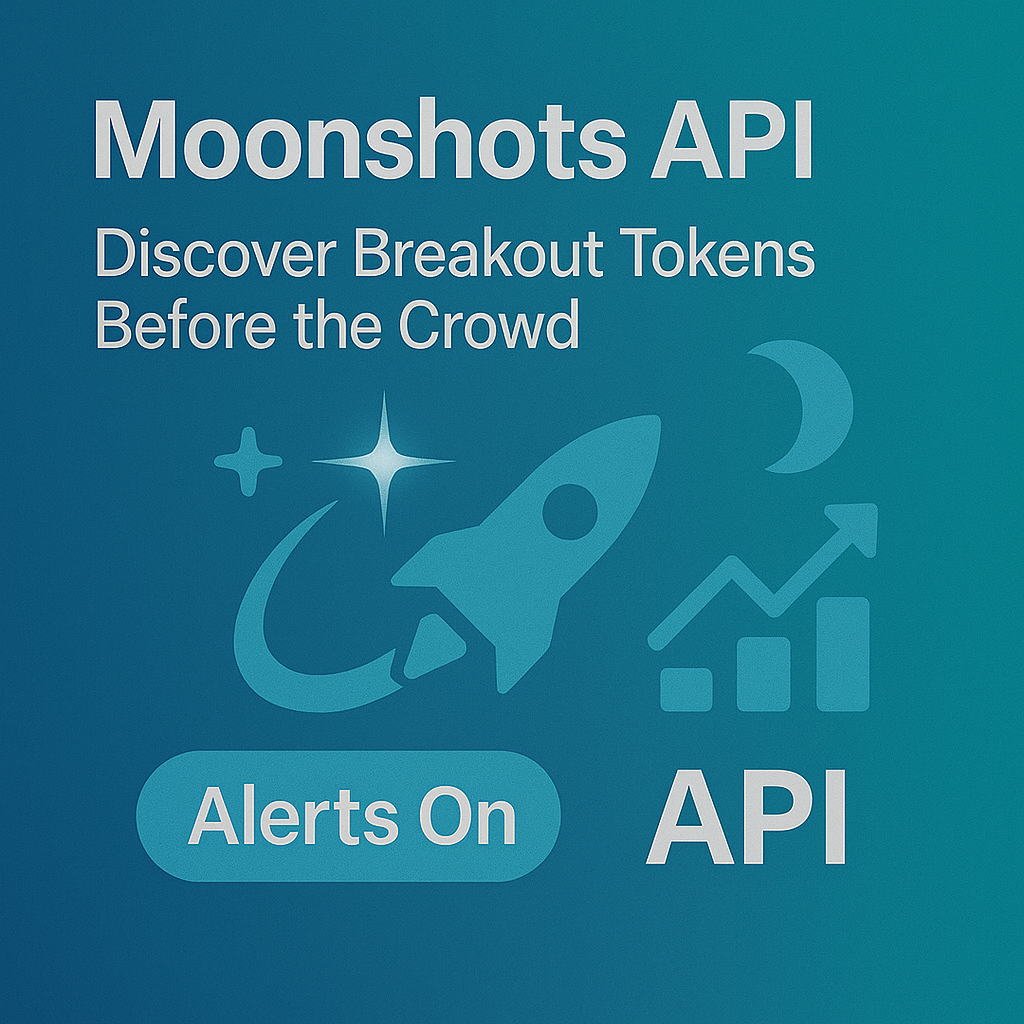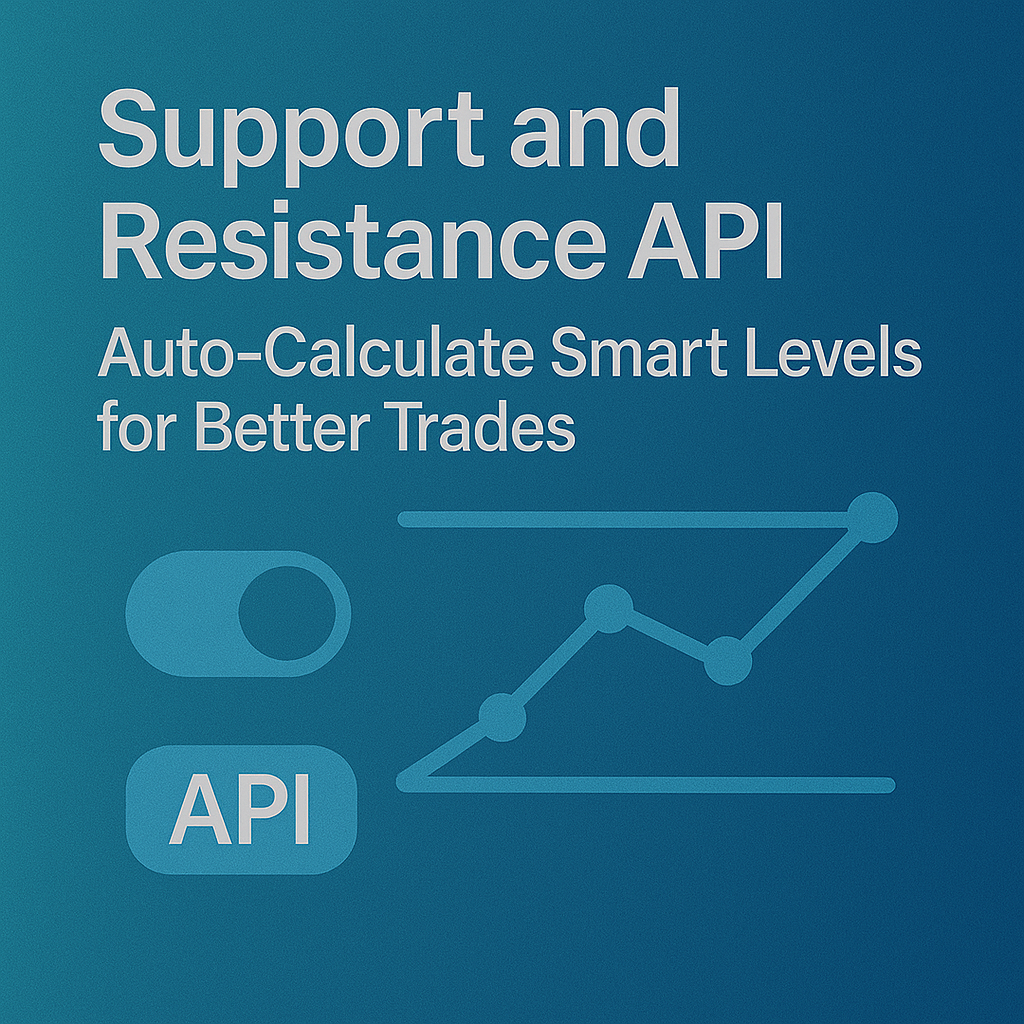Top Crypto Trading Platforms in 2025







%201.svg)
%201.svg)
Big news: We’re cranking up the heat on AI-driven crypto analytics with the launch of the Token Metrics API and our official SDK (Software Development Kit). This isn’t just an upgrade – it's a quantum leap, giving traders, hedge funds, developers, and institutions direct access to cutting-edge market intelligence, trading signals, and predictive analytics.
Crypto markets move fast, and having real-time, AI-powered insights can be the difference between catching the next big trend or getting left behind. Until now, traders and quants have been wrestling with scattered data, delayed reporting, and a lack of truly predictive analytics. Not anymore.
The Token Metrics API delivers 32+ high-performance endpoints packed with powerful AI-driven insights right into your lap, including:
Getting started with the Token Metrics API is simple:
At Token Metrics, we believe data should be decentralized, predictive, and actionable.
The Token Metrics API & SDK bring next-gen AI-powered crypto intelligence to anyone looking to trade smarter, build better, and stay ahead of the curve. With our official SDK, developers can plug these insights into their own trading bots, dashboards, and research tools – no need to reinvent the wheel.
%201.svg)
%201.svg)
The biggest gains in crypto rarely come from the majors. They come from Moonshots—fast-moving tokens with breakout potential. The Moonshots API surfaces these candidates programmatically so you can rank, alert, and act inside your product. In this guide, you’ll call /v2/moonshots, display a high-signal list with TM Grade and Bullish tags, and wire it into bots, dashboards, or screeners in minutes. Start by grabbing your key at Get API Key, then Run Hello-TM and Clone a Template to ship fast.
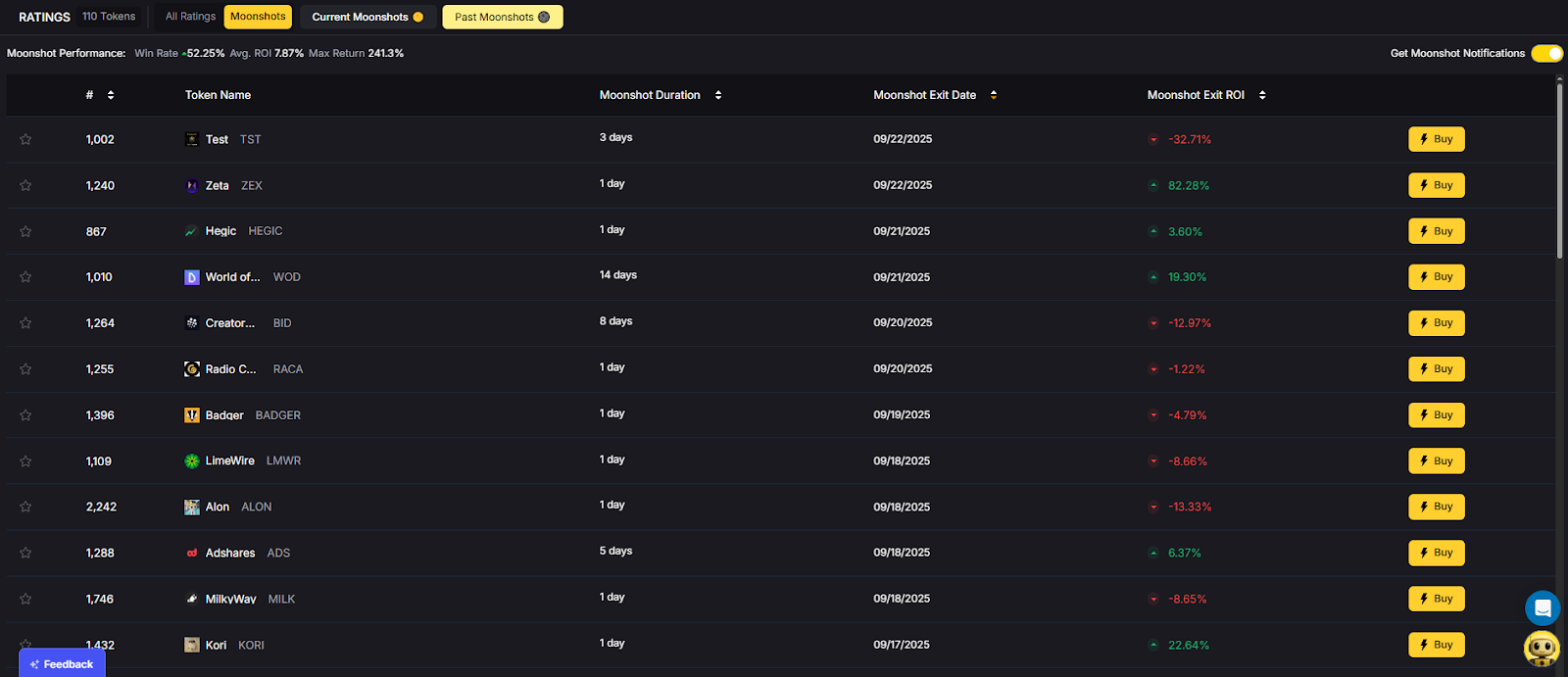
Discovery that converts. Users want more than price tickers—they want a curated, explainable list of high-potential tokens. The moonshots API encapsulates multiple signals into a short list designed for exploration, alerts, and watchlists you can monetize.
Built for builders. The endpoint returns a consistent schema with grade, signal, and context so you can immediately sort, badge, and trigger workflows. With predictable latency and clear filters, you can scale to dashboards, mobile apps, and headless bots without reinventing the discovery pipeline.
The Moonshots API cURL request is right there in the top right of the API Reference. Grab it and start tapping into the potential!
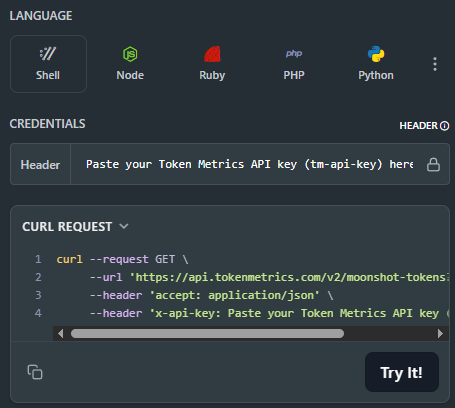
👉 Keep momentum: Get API Key • Run Hello-TM • Clone a Template
Fork a screener or alerting template, plug your key, and deploy. Validate your environment with Hello-TM. When you scale users or need higher limits, compare API plans.
The Moonshots endpoint aggregates a set of evidence—often combining TM Grade, signal state, and momentum/volume context—into a shortlist of breakout candidates. Each row includes a symbol, grade, signal, and timestamp, plus optional reason tags for transparency.
For UX, a common pattern is: headline list → token detail where you render TM Grade (quality), Trading Signals (timing), Support/Resistance (risk placement), Quantmetrics (risk-adjusted performance), and Price Prediction scenarios. This lets users understand why a token was flagged and how to act with risk controls.
Polling vs webhooks. Dashboards typically poll with short-TTL caching. Alerting flows use scheduled jobs or webhooks (where available) to smooth traffic and avoid duplicates. Always make notifications idempotent.
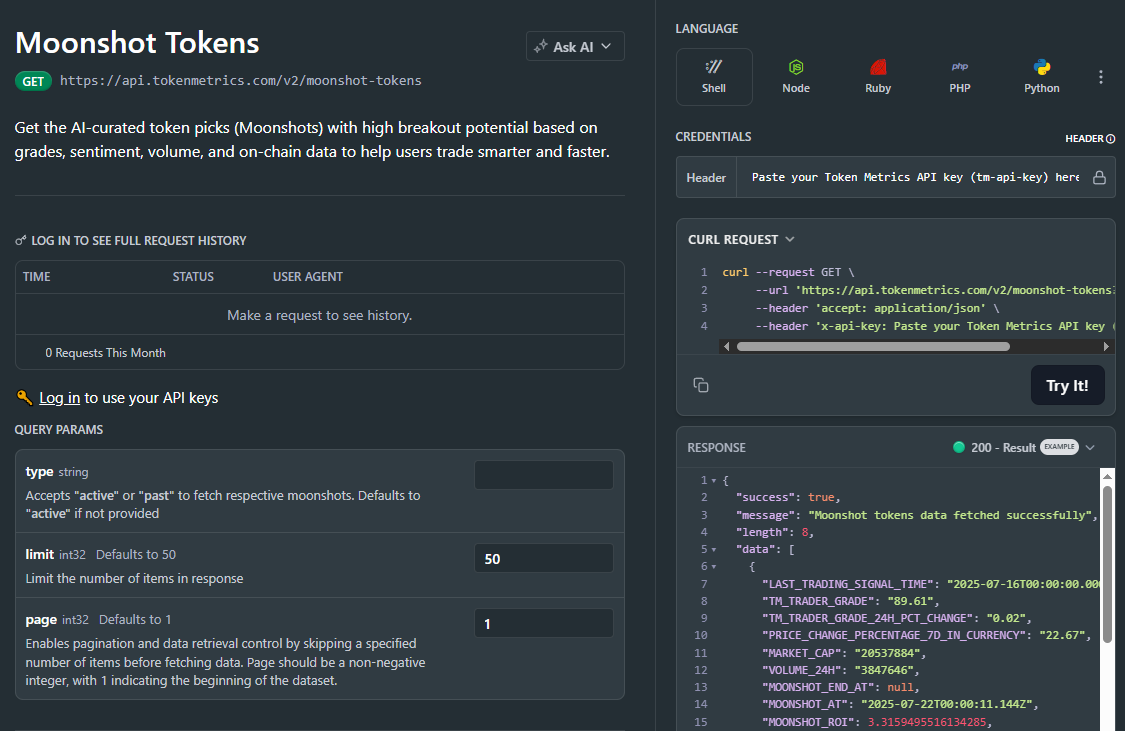
1) What does the Moonshots API return?
A list of breakout candidates with fields such as symbol, tm_grade, signal (often Bullish/Bearish), optional reason tags, and updated_at. Use it to drive discover tabs, alerts, and watchlists.
2) How fresh is the list? What about latency/SLOs?
The endpoint targets predictable latency and timely updates for dashboards and alerts. Use short-TTL caching and queued jobs/webhooks to avoid bursty polling.
3) How do I use Moonshots in a trading workflow?
Common stack: Moonshots for discovery, Trading Signals for timing, Support/Resistance for SL/TP, Quantmetrics for sizing, and Price Prediction for scenario context. Always backtest and paper-trade first.
4) I saw results like “+241%” and a “7.5% average return.” Are these guaranteed?
No. Any historical results are illustrative and not guarantees of future performance. Markets are risky; use risk management and testing.
5) Can I filter the Moonshots list?
Yes—pass parameters like min_grade, signal, and limit (as supported) to tailor to your audience and keep pages fast.
6) Do you provide SDKs or examples?
REST works with JavaScript and Python snippets above. Docs include quickstarts, Postman collections, and templates—start with Run Hello-TM.
7) Pricing, limits, and enterprise SLAs?
Begin free and scale up. See API plans for rate limits and enterprise options.
%201.svg)
%201.svg)
Most traders still draw lines by hand in TradingView. The support and resistance API from Token Metrics auto-calculates clean support and resistance levels from one request, so your dashboard, bot, or alerts can react instantly. In minutes, you’ll call /v2/resistance-support, render actionable levels for any token, and wire them into stops, targets, or notifications. Start by grabbing your key on Get API Key, then Run Hello-TM and Clone a Template to ship a production-ready feature fast.
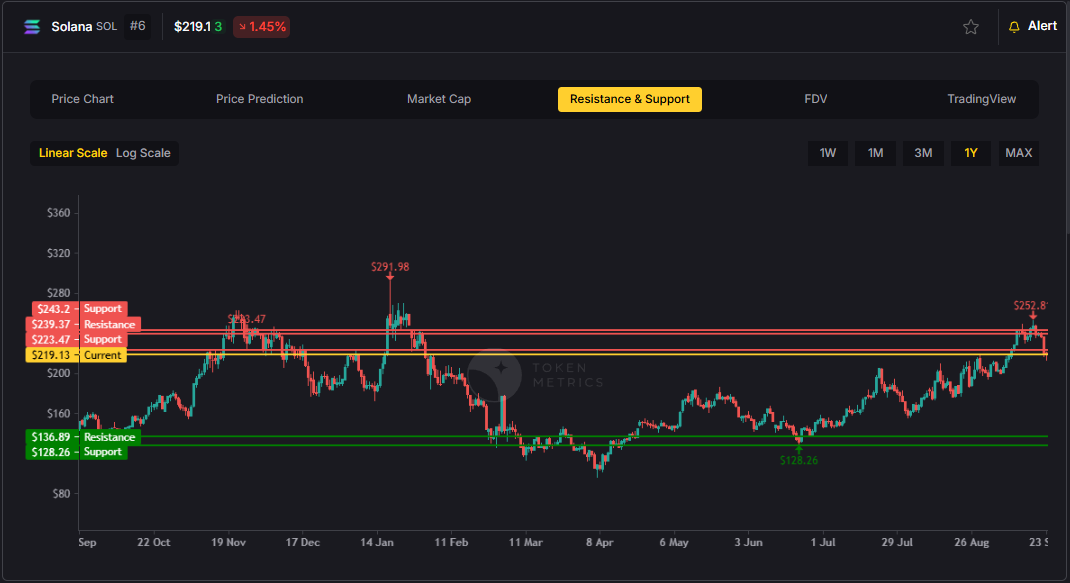
Precision beats guesswork. Hand-drawn lines are subjective and slow. The support and resistance API standardizes levels across assets and timeframes, enabling deterministic stops and take-profits your users (and bots) can trust.
Production-ready by design. A simple REST shape, predictable latency, and clear semantics let you add levels to token pages, automate SL/TP alerts, and build rule-based execution with minimal glue code.
Need the Support and Resistance data? The cURL request for it is in the top right of the API Reference for quick access.
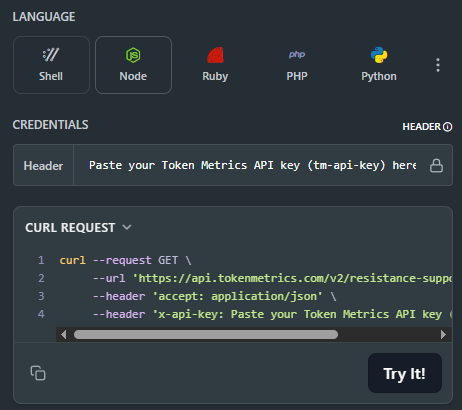
👉 Keep momentum: Get API Key • Run Hello-TM • Clone a Template
Kick off with our quickstarts—fork a bot or dashboard template, plug your key, and deploy. Confirm your environment by Running Hello-TM. When you’re scaling or need webhooks/limits, review API plans.
The Support/Resistance endpoint analyzes recent price structure to produce discrete levels above and below current price, along with strength indicators you can use for priority and styling. Query /v2/resistance-support?symbol=<ASSET>&timeframe=<HORIZON> to receive arrays of level objects and timestamps.
Polling vs webhooks. For dashboards, short-TTL caching and batched fetches keep pages snappy. For bots and alerts, use queued jobs or webhooks (where applicable) to avoid noisy, bursty polling—especially around market opens and major events.
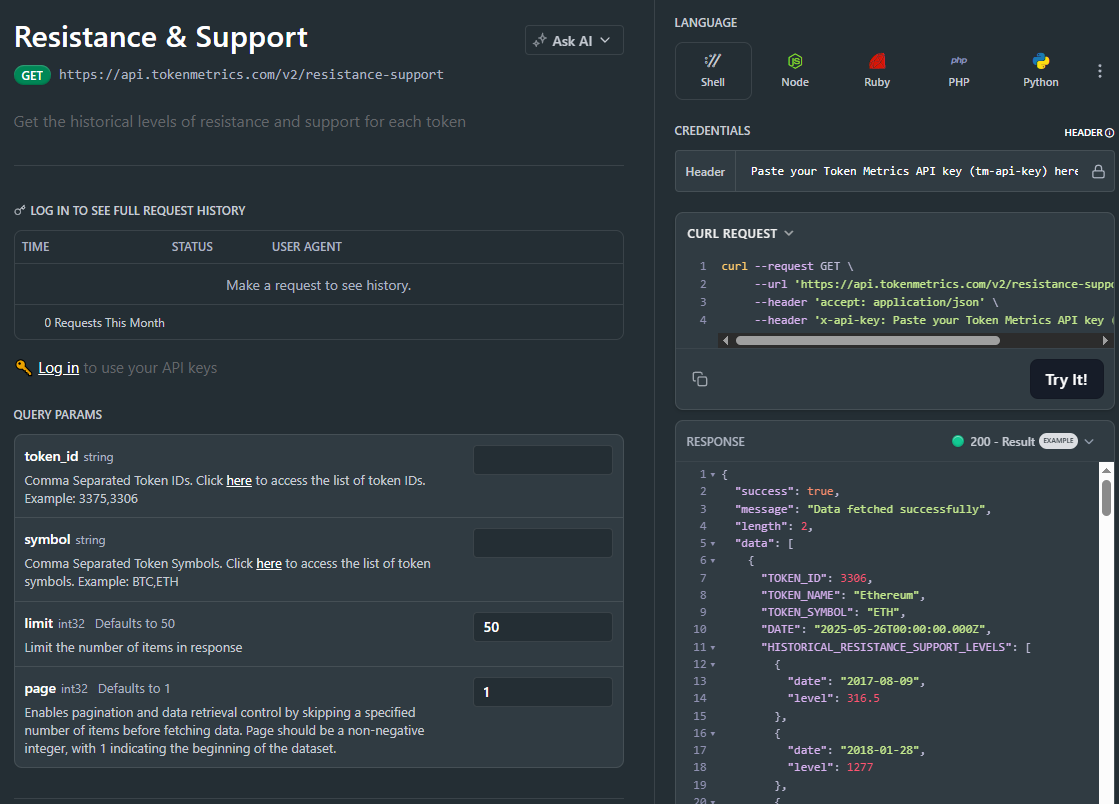
1) What does the Support & Resistance API return?
A JSON payload with arrays of support and resistance levels for a symbol (and optional timeframe), each with a price and strength indicator, plus an update timestamp.
2) How timely are the levels? What are the latency/SLOs?
The endpoint targets predictable latency suitable for dashboards and alerts. Use short-TTL caching for UIs, and queued jobs or webhooks for alerting to smooth traffic.
3) How do I trigger alerts or trades from levels?
Common patterns: alert when price is within X% of a level, touches a level, or breaks beyond with confirmation. Always make downstream actions idempotent and respect rate limits.
4) Can I combine levels with other endpoints?
Yes—pair with /v2/trading-signals for timing, /v2/tm-grade for quality context, and /v2/quantmetrics for risk sizing. This yields a complete decide-plan-execute loop.
5) Which timeframe should I use?
Intraday bots prefer shorter horizons; swing/position dashboards use daily or higher-timeframe levels. Offer a timeframe toggle and cache results per setting.
6) Do you provide SDKs or examples?
Use the REST snippets above (JS/Python). The docs include quickstarts, Postman collections, and templates—start with Run Hello-TM.
7) Pricing, limits, and enterprise SLAs?
Begin free and scale as you grow. See API plans for rate limits and enterprise SLA options.
%201.svg)
%201.svg)
Most traders see price—quants see probabilities. The Quantmetrics API turns raw performance into risk-adjusted stats like Sharpe, Sortino, volatility, drawdown, and CAGR so you can compare tokens objectively and build smarter bots and dashboards. In minutes, you’ll query /v2/quantmetrics, render a clear performance snapshot, and ship a feature that customers trust. Start by grabbing your key at Get API Key, Run Hello-TM to verify your first call, then Clone a Template to go live fast.
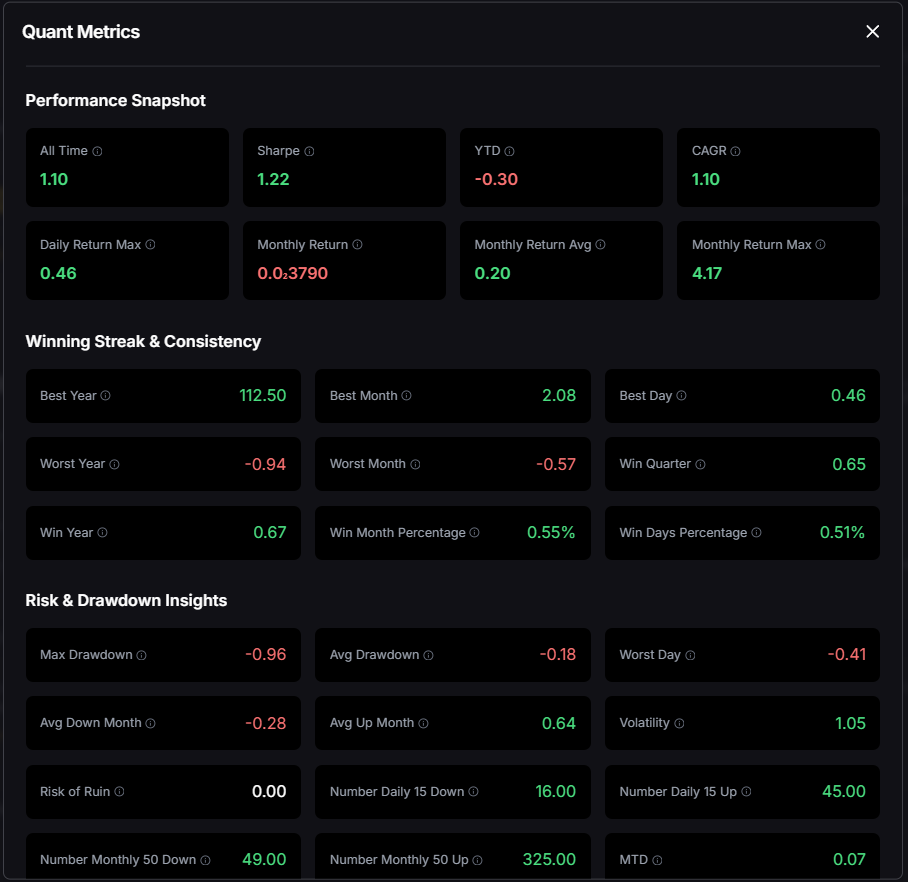
Risk-adjusted truth beats hype. Price alone hides tail risk and whipsaws. Quantmetrics compresses edge, risk, and consistency into metrics that travel across assets and timeframes—so you can rank universes, size positions, and communicate performance like a pro.
Built for dev speed. A clean REST schema, predictable latency, and easy auth mean you can plug Sharpe/Sortino into bots, dashboards, and screeners without maintaining your own analytics pipeline. Pair with caching and batching to serve fast pages at scale.
The Quant Metrics cURL request is located in the top right of the API Reference, allowing you to easily integrate it with your application.
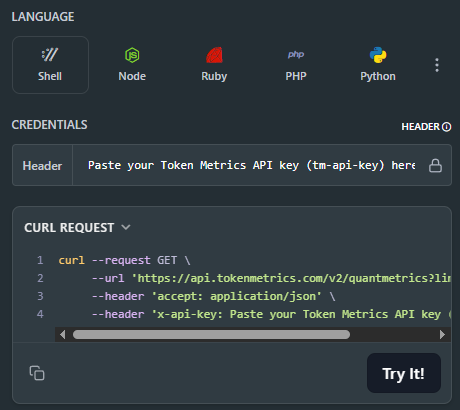
👉 Keep momentum: Get API Key • Run Hello-TM • Clone a Template
Kick off from quickstarts in the docs—fork a dashboard or screener template, plug your key, and deploy in minutes. Validate your environment with Run Hello-TM; when you need more throughput or webhooks, compare API plans.
Quantmetrics computes risk-adjusted performance over a chosen lookback (e.g., 30d, 90d, 1y). You’ll receive a JSON snapshot with core statistics:
Call /v2/quantmetrics?symbol=<ASSET>&window=<LOOKBACK> to fetch the current snapshot. For dashboards spanning many tokens, batch symbols and apply short-TTL caching. If you generate alerts (e.g., “Sharpe crossed 1.5”), run a scheduled job and queue notifications to avoid bursty polling.
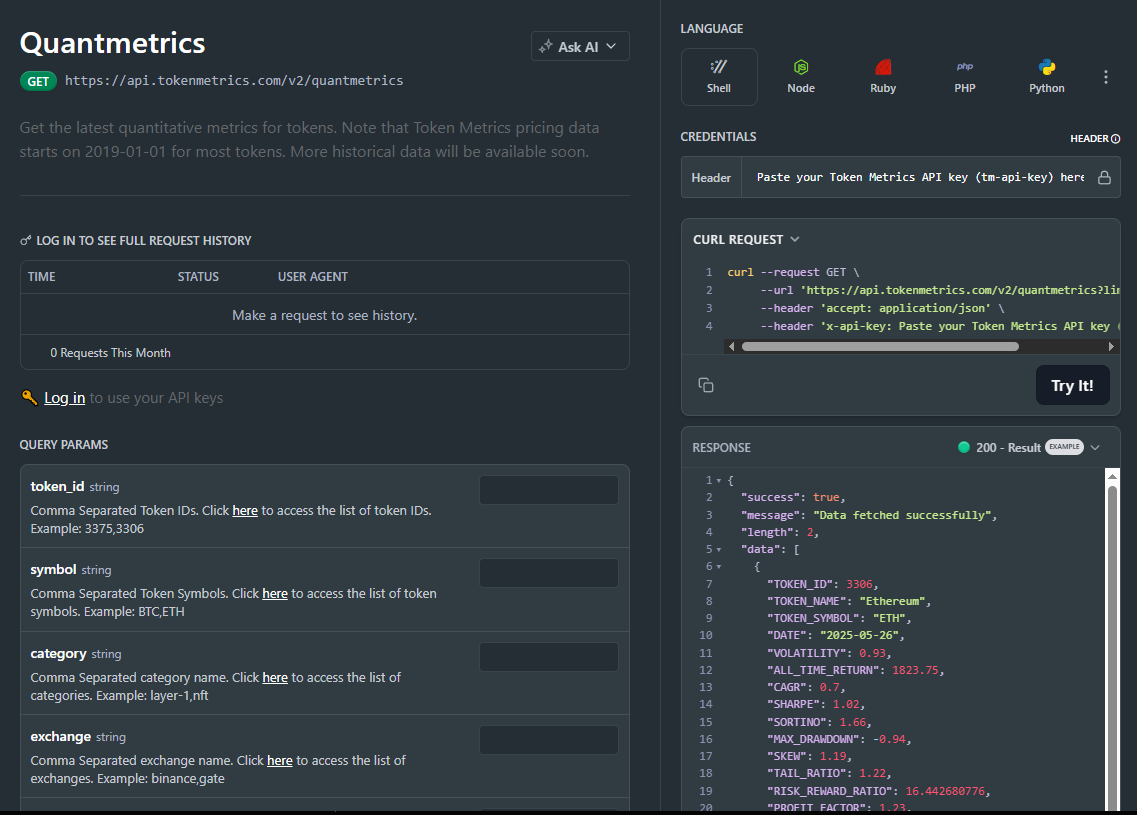
1) What does the Quantmetrics API return?
A JSON snapshot of risk-adjusted metrics (e.g., Sharpe, Sortino, volatility, max drawdown, CAGR) for a symbol and lookback window—ideal for ranking, sizing, and dashboards.
2) How fresh are the stats? What about latency/SLOs?
Responses are engineered for predictable latency. For heavy UI usage, add short-TTL caching and batch requests; for alerts, use scheduled jobs or webhooks where available.
3) Can I use Quantmetrics to size positions in a live bot?
Yes—many quants size inversely to volatility or require Sharpe ≥ X to trade. Always backtest and paper-trade before going live; past results are illustrative, not guarantees.
4) Which lookback window should I choose?
Short windows (30–90d) adapt faster but are noisier; longer windows (6–12m) are steadier but slower to react. Offer users a toggle and cache each window.
5) Do you provide SDKs or examples?
REST is straightforward (JS/Python above). Docs include quickstarts, Postman collections, and templates—start with Run Hello-TM.
6) Polling vs webhooks for quant alerts?
Dashboards usually use cached polling. For threshold alerts (e.g., Sharpe crosses 1.0), run scheduled jobs and queue notifications to keep usage smooth and idempotent.
7) Pricing, limits, and enterprise SLAs?
Begin free and scale up. See API plans for rate limits and enterprise SLA options.

%201.svg)
%201.svg)
Do you want to know what causes crypto to rise? This is the place to be.
Cryptocurrency prices are highly volatile and can fluctuate rapidly, which can be both good and bad for investors. To understand what causes crypto to rise in value, it's important to first understand how cryptocurrencies differ from traditional government-controlled currencies. Unlike fiat currencies, which are backed by a central authority and have value because consumers trust them, cryptocurrencies are decentralized and not controlled by any one entity. This means that cryptocurrencies gain value in different ways than traditional currencies. In this article, we will explore some of the factors that can cause the value of cryptocurrencies to increase.
Let's find out what causes cryptocurrencies to rise in value.
The value of cryptocurrency is determined by supply and demand, just like any other asset. When demand for a particular cryptocurrency is higher than the supply, its value will increase. For example, if there is a scarcity of a certain cryptocurrency, its value will rise due to the unequal balance between supply and demand.
Each cryptocurrency project typically announces its plans for minting and burning tokens, which is the process of creating and destroying tokens to control the supply. Some cryptocurrencies, such as Bitcoin, have a fixed maximum supply, while others, such as Ether, have no limit on the number of tokens that can be created. Some cryptocurrencies also have mechanisms in place to burn tokens in order to prevent the circulating supply from growing too large and causing inflation.
The demand for a cryptocurrency can increase for a variety of reasons, such as increased awareness of the project or increased utility of the token. So, one factor that can cause the value of a cryptocurrency to rise is consumer demand for that particular coin.
Popular cryptocurrencies like Bitcoin and Ether are typically available on multiple exchange platforms, which makes them easily accessible to a large number of investors. However, smaller cryptocurrencies may only be available on a few exchange platforms, which can limit their reach and make them less attractive to investors.
If a cryptocurrency is listed on many exchange platforms, it can increase the number of investors who are able to buy it and drive up demand. As we know, when demand for a cryptocurrency increases, its price will also rise. So, another factor that can cause the value of a cryptocurrency to increase is its availability on exchange platforms.
There are thousands of different cryptocurrencies and new projects and tokens are being launched all the time. Because the entry barriers to creating a new cryptocurrency are relatively low, the most important aspect of a cryptocurrency's success is building a network of users. Applications built on blockchain technology can help to build networks quickly, especially if they have an advantage over competing applications.
In a situation where a new competitor gains traction, it can take value away from the incumbent cryptocurrency, causing its price to drop as the new competitor's price rises. Overall, competition is an important factor to consider when looking at the value of a cryptocurrency.
Cryptocurrency networks typically operate according to a fixed set of rules. Some cryptocurrencies, known as governance tokens, allow stakeholders to have a say in the future of the project, including how the token is used or mined. In order for changes to be made to the protocol of a token, there must be agreement among stakeholders.
For example, the Ethereum network upgraded from a proof-of-work to a proof-of-stake consensus mechanism, making much of the expensive mining equipment obsolete. This will likely have an impact on the value of Ether.
In theory, governance tokens should rise in value as stakeholders see fit. However, the slow process of improving protocols and updating software can limit the appreciation of cryptocurrency values.

%201.svg)
%201.svg)
KYC, or "know your customer," is a term used to describe the identity and background checks that financial institutions are required to conduct on their customers. These checks are important for risk mitigation and are part of the Anti-Money Laundering (AML) regulations that these institutions must follow. In the cryptocurrency space, KYC regulations are becoming increasingly important as more and more people use digital assets for financial transactions. By conducting KYC checks, cryptocurrency exchanges and other financial institutions can help prevent money laundering and other illegal activities.
The United States government has implemented a number of measures to help financial service institutions detect and prevent financial crimes. These measures were established by the USA Patriot Act of 2001 and were finalized in 2002, making KYC (know your customer) checks mandatory for all US financial institutions. In 2016, the Department of Treasury's Financial Crimes Enforcement Network (FinCEN) expanded these regulations to include the FinTech sector, which resulted in virtual currency exchange platforms being declared official money services businesses under the Bank Secrecy Act. This means that these platforms are subject to all AML (anti-money laundering) and KYC requirements.
While it is up to regulated entities (banks, crypto exchanges, and other financial institutions) to implement the specifics of KYC and AML regulations, the KYC practices and programs generally include three essential components:
KYC regulations aim to discern that customers are who they say they are. This helps to prevent money laundering, terrorist financing, and fraud within the financial market.
Know Your Customer and other Anti-Money Laundering regulations benefit both financial institutions and their clients. These rules improve security and mitigate risk by keeping bad actors off the books. This acts as an assurance for customers and leads to a more trustworthy company-client relationship.
The cryptocurrency industry is still relatively new, and its decentralized nature can make it difficult to implement KYC (know your customer) measures. Crypto regulations are also still evolving as regulators seek to prevent financial crimes using cryptocurrencies and blockchain technology. As mentioned, crypto exchanges are considered official money services businesses and are therefore subject to KYC rules. These rules require exchanges to conduct identity and background checks on their customers, which may include requiring a photo ID. Many exchanges only allow transactions to occur once KYC is completed, especially for large sums of money.
However, some exchanges may try to avoid these rules by establishing their companies in countries with less stringent regulations. Exchanges that do not follow KYC and AML laws may not be available to use in countries that have these laws. This is why implementing KYC practices can actually increase an exchange's global reach by making it available in countries that have these laws, such as the US.
As the FinTech industry continues to grow and develop, it is important to regulate and mitigate risks to prevent illegal or suspicious behavior. AML laws are essential for ensuring fairness and equity in the emerging financial technology industry. Over time, regulations will continue to evolve to keep pace with the rapidly changing market.

%201.svg)
%201.svg)
There are a few reasons why people might want to know the closing time of the market. First, knowing the closing time can help traders plan their buying and selling activities around the times when the market is most active. This can help them take advantage of price movements and increase their chances of making profitable trades. Second, knowing the closing time can also help investors manage their risk by allowing them to set limits on their trading activities. For example, an investor may want to avoid holding positions overnight in case of significant price movements while the market is closed.
If you want to trade cryptocurrencies, you may be wondering when the crypto market closes. We're here to provide the answer to that question and more.
The cryptocurrency market, unlike the stock exchange, does not close. Crypto markets are open 24/7, so you can buy, sell, and swap cryptocurrencies anytime you want. The 24/7 nature of the cryptocurrency market is a significant advantage for traders and investors. Because the market never closes, traders can respond to news and events as they happen, rather than having to wait for the market to open. This allows for more flexibility and can potentially lead to better trading decisions.
Additionally, the continuous trading activity in the crypto market can lead to increased liquidity and tighter spreads, which can make it easier for traders to buy and sell cryptocurrencies at the prices they want. This can be especially beneficial for investors who want to take advantage of short-term price movements or who need to execute large trades quickly.
Furthermore, the fact that the crypto market is always open can be useful for traders in different time zones. Because the market never closes, traders in any part of the world can access it and make trades at any time. This is particularly useful for traders who may not be able to trade during normal market hours due to work or other commitments.
Cryptocurrencies are most commonly traded between 8:00 am and 4:00 pm in local time. As a rule of thumb, the market tends to see most of its activity take place on weekdays during the times in which the US stock exchange is open.
The day trading method involves trading one or more shares during a given day to earn profits. It is buying and selling an asset (in this case, a cryptocurrency) within the same day or multiple times over the day. This allows the trader to take advantage of small price moves, which can be very lucrative. To thrive in crypto day trading, keeping your eye on the charts, analytics, and community announcements is very important. Token Metrics provides many of these valuable insights, thanks to our AI and Machine Learning models.
The strategy of day trading contrasts the popular buy and hold, aka HODL strategy, but it does have certain benefits for traders. It is essential to have a well-planned strategy for day trading to succeed in maximizing profits.
Range trading is a common strategy for day trading cryptocurrencies. This involves monitoring the market for drastic changes in price and volume, and buying and selling accordingly. For example, if you notice that the volume of a particular cryptocurrency has increased significantly, you may want to buy it when it reaches an oversold level and sell it when it reaches an overbought level. By doing this, you can take advantage of short-term price movements and potentially profit from them. It's important to remember, however, that the small market caps of many cryptocurrencies make them susceptible to manipulation by large buyers, so it's essential to carefully monitor the market and make informed trading decisions.
Another popular strategy is employing bots to automate your crypto investments. Certain platforms allow traders to customize trading bots to buy low and sell high. Platforms like these use bots to read the markets and let traders break from constantly tracking the blockchain themselves. Similarly, scalping allows traders to benefit from small price movements. Many scalpers use bots to accumulate smaller gains by buying and selling a crypto asset within seconds. Scalping tends to necessitate a larger bankroll to benefit to a greater extent.
The final way in which crypto traders can take advantage of day trading is through arbitrage. Arbitrage involves buying a cryptocurrency on one exchange market and selling it on another where a price discrepancy exists. The fact that the crypto market is unregulated allows for price discrepancies to take place between trading exchange markets. This means a specific cryptocurrency may sell for more on one market than another. This is known as trading the spread. A spread is the difference in a coin's buy and sell price on different platforms.
Traders must consider trading fees when using any day trading tactic, as trading fees may wipe out gains from multiple transactions.
The cryptocurrency market is non-stop. Crypto traders are not limited to trading hours, like stock or bond traders. There are a multitude of ways in which crypto traders can take advantage of the ever-changing market by implementing day-trading strategies. It is important to understand the volatility and risks that come with trading cryptocurrencies. It is best to take a measured approach when trading and investing in crypto, and do your own research to understand what tactics would provide significant profits and help achieve your investing goals.

%201.svg)
%201.svg)
We are proud to announce Token Metrics Research, a dedicated platform to host all our research for our customers and crypto enthusiasts out there.
Token Metrics is an AI-driven crypto research platform. We bring to you the smartness of machine learning and Artificial Intelligence (AI) by blending the expertise of our investment team, data scientists, and developers to deliver comprehensive institutional-grade research. To help navigate this new asset class we have a team of analysts dedicatedly to researching the crypto space and producing research reports.
For the past years, we have delivered premium research for our customers through our email newsletters, Token Metrics TV and our Youtube channel. We received feedback to have an archive and dedicated platform for all research media, so we created – Token Metrics Research.
*Token Metrics TV will be accessible through research.tokenmetrics.com*
Non-Customers can read all articles labeled ‘Free’ including Crypto Basics, Token Metrics Tutorials, Crypto Moon Awards, and News and Thought-Leadership articles. Non-customers can also read any two premium reports per month for Free. All Shows on Token Metrics TV are FREE with the exception of premium customer webinars.
Basic Plan subscribers can read all Free articles, Token Metrics Navigator (published weekly) and any two Premium reports per month for Free. Basic Plan subscribers can also add all premium reports to their subscription for an additional $20/month. All Shows on Token Metrics TV are FREE including our daily market update with the exception of the premium webinars.
Advanced Plan subscribers can read all free articles and premium reports. All Shows on Token Metrics TV are FREE including our daily market update with the exception of the premium webinars.
Premium and VIP Plan subscribers have access to all free and premium reports. All Shows on Token Metrics TV are FREE including our daily market update. The premium webinar recordings are also hosted on our research blog.
Not yet a Token Metrics subscriber? See the Token Metrics pricing page, here.

%201.svg)
%201.svg)
NFTs, or non-fungible tokens, are gaining widespread popularity in the market for digital art and collectibles. In recent years, NFTs have become a cultural phenomenon, attracting the attention of crypto enthusiasts, digital art creators, and celebrities alike. As the Web 3.0 ecosystem continues to grow and adoption increases, many believe that NFTs will play a key role in the ownership of assets online.
So what are NFTs? Let's find out.
NFTs, or non-fungible tokens, are a type of digital asset that represents ownership of something on the blockchain.
NFTs can be anything such as art, collectibles, music, profile pictures or PFP, DAO memberships, event tickets, gaming assets, virtual land, domain names, and so on. They can represent either completely digital assets or tokenized versions of assets that exist in the real world. Currently, there is a lot of excitement around using NFTs to sell virtual art.
To create an NFT, or non-fungible token, you will need to first prepare your media file. NFTs can support a wide range of file types, including audio, images, and even 3D files. Some popular file types that are supported by NFTs include MP3, JPG, PNG, and GIF. You can also use 3D file formats like GLB to create NFTs that represent unique, digital objects.
Once your media is ready, you will need to set up a non-custodial wallet to securely store the cryptocurrency that you will use to buy, sell, and create NFTs. Non-custodial wallets are important because they allow you to retain control of your private keys, which are needed to access your cryptocurrency and make transactions. There are many different wallet options available, so it is important to do your research and choose one that is secure and user-friendly.
Once you have set up your wallet, you will need to buy Ethereum, or other fungible tokens depending on the blockchain being used, to cover the cost of minting your NFT. Ethereum is the most commonly used blockchain for NFTs, and it is typically the easiest to get started with. You can buy Ethereum using a variety of methods, including through a cryptocurrency exchange or from other individuals who are willing to sell.
Once you have your Ethereum, you will need to connect your wallet to an NFT marketplace like Rarible or OpenSea. These platforms allow you to easily create and mint your NFT, as well as trade and purchase NFTs created by others. To connect your wallet, simply tap the "Connect" button in the top right corner of the marketplace's website. This will create an account for you on the platform and allow you to begin creating your NFT.
To create your NFT, upload your media file to the platform and provide a description of your asset. You can choose to create a standalone piece, or create multiple NFTs of the same piece, each with its own unique characteristics. You can also set rules around royalties and other aspects of your NFT to ensure that you are fairly compensated for your work.
Once you are ready to mint your NFT, the process will require you to pay a small amount of ETH for transaction fees. This is necessary to get your NFT added to the blockchain and verified as unique. Once your NFT is minted, it will be available for trade and purchase on the marketplace. You can monitor the progress of your NFT and track its sales through your wallet or the marketplace's website.
Creators make NFTs using blockchain-based minting platforms to retain more control over their creative output. Once NFTs are minted on a non-custodial wallet-compatible website, collectors and traders can sell these assets on the secondary market.
Here is a list of the most used NFT marketplaces:
NFT-based companies have seen significant growth in recent years. Some notable examples include:
NFTs, or non-fungible tokens, provide many benefits as an investment vehicle.
One of the main advantages of NFTs is that they allow physical objects, such as artwork, to be tokenized.
Additionally, NFTs offer greater liquidity for investors, making it easier to trade and sell their assets.
NFTs offer a new way to represent and prove ownership of assets on the blockchain.
This technology has already been used for digital art, collectibles, and in-game assets, but it has the potential to be applied to a wide range of other industries as well. For example, tokenized real estate could provide a way for people to invest in property without the barriers to entry that currently exist.
High-end fashion brands like Louis Vuitton have also expressed interest in using NFTs to track the ownership of luxury items.
Additionally, NFTs can be used to tokenize certifications, degrees, and licenses, providing a way to securely track and maintain this sensitive data on the blockchain.
Overall, the potential applications for NFTs are nearly limitless.

%201.svg)
%201.svg)
If you are looking for ways to earn free crypto this year, in 2024, this is the place to be. Yes, it is possible to earn free cryptocurrency by participating in certain activities or using certain services. For example, some websites and apps offer rewards in the form of cryptocurrency for completing tasks, such as answering surveys or watching videos.
Additionally, some cryptocurrencies, such as Bitcoin and Ethereum, can be earned through a process called mining, in which individuals use their computer's processing power to help verify and record transactions on the blockchain.
However, it is important to be cautious when seeking out opportunities to earn free cryptocurrency, as there are many scams and fraudulent schemes that claim to offer free crypto but actually steal users' personal information or funds. It is always a good idea to thoroughly research any opportunity before participating and to use only trusted and reputable sources.
Many people never invest in cryptocurrencies due to fear of losing their money, or because they do not have enough money to invest in the first place. However, there are several ways to get cryptocurrencies for free without risking any of your own money.
Let's explore them all.
Learn and Earn platforms are a great way to earn free crypto while also gaining knowledge about the industry. These platforms, such as Coinbase and CoinMarketCap, offer users the opportunity to learn about specific coins and earn rewards in exchange.
To participate in a Learn and Earn platform, users typically need to open an account and pass a KYC verification. Once verified, users can access educational materials and quizzes on the platform, and earn rewards for completing them. These platforms regularly update their offerings, so it is important to check back frequently to see what new opportunities are available.
Airdrops are a popular method of earning free crypto. These are marketing campaigns drawn up by new crypto platforms to gain visibility and increase their customer base. As part of their marketing strategy, these platforms give out free coins to new and existing users in exchange for creating awareness about their project.
To qualify for an airdrop, users must typically be active crypto traders or at least have a crypto wallet. Airdrops can be a win-win for both the trading platform and the user, as the platform gains visibility and the user earns free crypto.
Play-to-earn games are a fun and exciting way to earn free crypto. These games allow users to have fun while also earning rewards in the form of crypto. Examples of these games include CoinHunt World, where users can explore a digital environment and earn rewards for finding keys and answering trivia questions, and Crypto Popcoin, where users can earn rewards by grouping cryptocurrencies together and popping them.
To earn actual crypto through these games, users typically need to register their ERC-20 wallet address and have the real crypto token airdropped to their account. Some games may also allow users to earn crypto through their Coinbase account.
Cryptocurrency dividends are a new way for investors to earn passive income through their digital assets. Similar to traditional stocks, some cryptocurrencies offer dividend payments to their holders as a reward for holding their tokens for a specific period.
These payments can be in the form of additional tokens or other cryptocurrencies, depending on the protocol. For instance, some blockchain networks offer staking rewards to users who lock up their coins to secure the network, while others distribute a portion of their transaction fees to token holders.
By earning crypto through dividends, investors can benefit from both capital appreciation and recurring income, potentially increasing their overall returns on investment. However, as with any investment, it is crucial to do thorough research and assess the risks before committing funds to any cryptocurrency project.
One way to earn crypto through credit cards is by using a credit card that offers rewards or cashback in the form of cryptocurrency. Several credit card companies now offer rewards in a form of cryptocurrencies. Users can earn rewards on their purchases and then transfer the earned crypto to their digital wallet.
Another option is to use a crypto credit card, which allows users to earn rewards in cryptocurrency directly. These cards work like traditional credit cards, but instead of earning cashback or points, users earn crypto rewards that can be redeemed for various products and services.
Referral bonuses are a common way for people to earn cryptocurrency without necessarily making a direct investment or engaging in trading. Referral programs are typically offered by cryptocurrency exchanges, wallets, and other platforms that offer a commission or bonus for referring new users to their services.
To earn crypto through referral bonuses, individuals simply need to share their unique referral links with friends, family, and acquaintances who might be interested in using the platform. When someone signs up using the link and completes certain actions, such as making a deposit or trading, the referrer receives a bonus in cryptocurrency.
Referral bonuses can vary in size and scope, but they can be a great way to earn crypto passively and without having to invest a significant amount of time or money.
Some search engines and browsers, such as Brave and Pre-search, offer rewards in the form of crypto for viewing ads or just browsing. This is a simple and easy way to earn free crypto without having to invest any money.
While earning free crypto can be a great way to get started in the world of cryptocurrency, it is important to be cautious. This is because not all opportunities to earn free crypto are legitimate or safe.
There are many scams and fraudulent schemes that claim to offer free crypto, but are actually designed to steal users' personal information or funds. These scams can take many forms, such as fake airdrops, fake games, or fake search engines that promise rewards but never actually deliver on them.
Therefore, it is important for users to carefully research and verify any opportunity to earn free crypto before participating. They should look for reputable platforms and sources, and be wary of any offers that seem too good to be true.
Additionally, users should always protect their personal information and crypto assets by using secure wallets and following best practices for online security.
The information provided on this website does not constitute investment advice, financial advice, trading advice, or any other advice, and you should not treat any of the website's content as such.
Token Metrics does not recommend buying, selling, or holding any cryptocurrency. Conduct your due diligence and consult your financial advisor before making investment decisions.

%201.svg)
%201.svg)
If you're wondering what is Web 3, this is the place to be.
In this article, we'll learn more about the evolution of web over time, and what's next.
Being around for 3 decades, the internet has gone through multiple stages of evolution. With each evolution comes new tools and applications relevant to modern-day users, leading us to Web 3.0.
The first generation of the web is called Web 1.0. As the earliest version of the internet, it is known as the “read-only web”. As its name implies, web users can look up facts and information and read upon it. Websites were basic and had very limited functions.
When it comes to Web 1.0, there is a lack of interactions that takes place between online internet content and internet users. Sites are not interactive and there are no contributions, alterations, or impacts that can be made by the average website visitor. Most common from the 1990s to 2005, Web 1.0 connected information with users.
This lack of interaction made Web 1.0 flat and stationary. As the name suggests, “the read-only Web” lacks the forms, visuals, controls, and interactivity we enjoy on today’s Internet. The developers of Web 1.0 sites typically build their sites and develop in text or graphic format.
Static websites and personal sites would be considered part of Web 1.0. Unlike today where many websites aim for high traffic and user return rates, content distributed on Web 1.0 may be useful but does not give people a reason to return.
Web 3.0, also known as the semantic web, is the current stage of the evolution of the web. It is characterized by the use of artificial intelligence and machine learning to create a more intuitive and personalized web experience.
Web 3.0 also enables the integration of data from multiple sources and the creation of intelligent, self-learning systems that can understand the meaning and context of information on the web. This stage of the web is still in development, but it promises to bring significant advancements in terms of user experience and the ability of the web to connect and analyze data.
The future stages of the internet will be built on public blockchains. Blockchains are distributed databases that are shared among a number of computer networks. Web 3.0 is decentralized, which means there is no central authority. This is possible because with Web 3.0, information is stored in multiple locations concurrently.
Additionally, because it is trustless and permissionless, anyone can interact with the web without permission from a middleman. This gives users the freedom to interact with the web privately or publicly without having to trust a middleman.
With Web 3.0, individuals finally have the ability to own and govern parts of the internet, rather than relying on companies like Google or Facebook to access it.
Web 3.0 is still very new, and we have not even come close to unlocking its full potential. Characteristics of Web 3.0 can already be seen in blockchain games, the Metaverse, and decentralized finance.
In short, Web 3.0 allows users to interact, exchange information, and securely facilitate different types of transactions without a central authority, which means that Web 3.0 users become content owners rather than just content users.
Web 3.0 offers several key benefits to users, including:
However, there are also disadvantages to Web 3.0, including:
The development of Web 3.0 represents a significant advancement in technology, offering users the ability to read, write, and own data and information. This technology is still in its early stages, but has the potential to break into other industries and change the way we think about data and information ownership. While there are benefits to using Web 3.0, there are also risks involved.
It is up to individuals to determine whether the rewards of using this technology outweigh the potential drawbacks. Overall, the development of Web 3.0 is a major event in the history of modern technology.

%201.svg)
%201.svg)
If you are wondering how to find new crypto coins, this is the place to be.
Finding new crypto coins has become important since the rise of Bitcoin and the wealth gained by early investors. The crypto market has experienced a surge of new investors who hope to find the next big coin, but many are unsure of how to navigate the space and identify new coins. It can be exciting to discover new coins, but it's important to beware of scams like the Squid token that exploited the popularity of the Squid Game movie series. Before looking for new crypto coins, here are some points to consider before making an investment decision.
A project's whitepaper is a good starting point for researching a new crypto project. Most new crypto projects have a whitepaper or official document that includes information such as the project's use case, tokenomics, team members, and roadmap. The presence or absence of a whitepaper can tell you a lot about the project's seriousness. While reading a project's whitepaper, there are a few things to look out for:
Use case: This is the main problem that the crypto project is trying to solve, or its unique function. For example, there are several Layer 2 projects that aim to improve the low latency and transaction times of traditional blockchains without compromising security and decentralization.
Tokenomics / Token Economics: This is the basic plan for how the project's new crypto tokens will be distributed. This includes how many tokens will go to the founding team, advisors, how many will be available for sale to the community, how many will be in the treasury, and what type of token it will be (deflationary or inflationary, with a limited or unlimited supply).
Lock-up period: This is the period of time that the founding team agrees to lock up their tokens before they can access them. A longer lock-up period can give investors more confidence in the project's long-term commitment.
Founding team: It's important to check the background of the project's founding team. Are they experienced, do their backgrounds match the project, and do they have any fraudulent history with past projects? The profiles of the advisors and investors/backers of the project can also be useful.
Social virality: Decentralization is at the core of crypto, so projects are often community-driven. The growth of the project's community can be a good indicator of investor confidence. Twitter, Telegram, and Discord are popular platforms for building crypto communities.
Roadmap: The project's roadmap contains its major plans and timeline. This can indicate the project's seriousness, especially when compared to what they have accomplished. Have they achieved any of the earlier plans on the roadmap within the specified timeline?
In addition, looking at the number of people on the project's watchlist, and whether it is listed on CoinMarketCap.com or CoinGecko, can also be a good confidence booster.
Before new crypto coins are listed on exchanges, they are often first offered as Initial Coin Offerings (ICOs), Initial Exchange Offerings (IEOs), or Initial Dex Offerings (IDOs). These offerings give investors the opportunity to get in early on projects before they go mainstream. This is where early investors can get into major projects before they are listed on crypto exchanges.
There are several platforms that feature upcoming crypto projects, including:
With over 10,000+ crypto coins, there are many opportunities out there. But there are also many shady platforms and crypto projects, so it's important to know how to find crypto with potential and make sure the projects are viable. Using the tips above can help you do that.


 Create Your Free Account
Create Your Free Account9450 SW Gemini Dr
PMB 59348
Beaverton, Oregon 97008-7105 US
.svg)




.png)
Token Metrics Media LLC is a regular publication of information, analysis, and commentary focused especially on blockchain technology and business, cryptocurrency, blockchain-based tokens, market trends, and trading strategies.
Token Metrics Media LLC does not provide individually tailored investment advice and does not take a subscriber’s or anyone’s personal circumstances into consideration when discussing investments; nor is Token Metrics Advisers LLC registered as an investment adviser or broker-dealer in any jurisdiction.
Information contained herein is not an offer or solicitation to buy, hold, or sell any security. The Token Metrics team has advised and invested in many blockchain companies. A complete list of their advisory roles and current holdings can be viewed here: https://tokenmetrics.com/disclosures.html/
Token Metrics Media LLC relies on information from various sources believed to be reliable, including clients and third parties, but cannot guarantee the accuracy and completeness of that information. Additionally, Token Metrics Media LLC does not provide tax advice, and investors are encouraged to consult with their personal tax advisors.
All investing involves risk, including the possible loss of money you invest, and past performance does not guarantee future performance. Ratings and price predictions are provided for informational and illustrative purposes, and may not reflect actual future performance.

